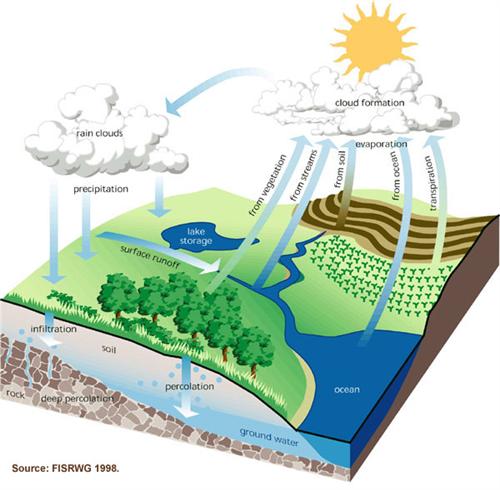The two most important aspects of climate are precipitation and temperature. Patterns of precipitation—the timing, amount, and form(rain, snow,etc)—and the range of temperatures characteristic of a region, affect the growth of vegetation, the development of soils, changes in landforms, distribution of animal life, and the availability of water. These in turn affect the way humans interact with the environment for shelter, food, clothing, and water.
The ‘hydrologic cycle’ describes the circulation of moisture in all physical states and situations. It tracks water as a solid (ice and snow), liquid (water) and gas (water vapour), whether in the atmosphere as clouds, falling to the earth as precipitation (rain and snow); on the surface of the earth as run-off and in river channels and waterbodies; and under the surface of the earth as soil water and groundwater. The hydrologic cycle is discussed in more detail in the Hydrology chapter.
The following aspects of the hydrologic cycle are critical to climate:
-
Precipitation
-
Evaporation
-
Evapotranspiration
Precipitation is the condensation of atmospheric moisture from water vapour to a liquid (rain) or solid (ice or snow) state, whereupon it falls to the Earth’s surface under gravity. Precipitation does not always reach the surface of the earth before it evaporates, but when it does, it is either absorbed into the soil where it becomes soil water or groundwater, or it forms runoff and drains into streams, rivers or other water bodies. Most southern African countries experience precipitation only as rain, but the Maloti Mountains of Lesotho receive snowfall each winter.
Evaporation refers to the loss of water from the surface of the earth, streams, rivers and water bodies and from soil and plant surfaces. Liquid water changes into vapour, driven by sunlight and aerodynamic effects such as wind and varying humidity. Factors that govern evaporation are energy supply, vapour transport and supply of moisture at the evaporative surface (soil moisture level). The first two affect evaporation from open water bodies, such as reservoirs, lakes or river surfaces. All three factors affects the amount of evapotranspiration from moist soil.
Transpiration is the loss of water from stomata and lenticels in a plant's leaves into the atmosphere.
Evapotranspiration is the combined process of evaporation from the Earth’s surface and transpiration from vegetation. The amount of evapotranspiration occurring in an area is determined by meteorological factors such as wind, air humidity, solar energy, latitude, lapse rate, etc. There are several methods for calculating evapotranspiration; however, the Penman-Monteith Method is widely used and recommended by the United Nations Food and Agriculture Organisation (FAO).

The Hydrologic (Water) Cycle.
Source:Federal Interagency Stream Restoration Working Group 1998
( click to enlarge )
